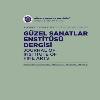Türkiye’de Doğal Olarak Yetişen Artemisia L. (Asteraceae) Cinsine Ait Üç Türün Morfolojik Özellikleri Bakımından İncelenmesi
Bu araştırmada, Türkiye’de doğal olarak yetişen ve sistematik açıdan birbirine çok yakın olan Artemisia haussknechtii Boiss., Artemisia. splendens Willd. ve Artemisia caucasica Willd. türleri morfolojik özellikleri bakımından incelenmiştir. Türkiye’de doğal yetişen Artemisia L. cinsinin bütün taksonları üç altcins (Artemisia, Dracunculus ve Seriphidium) içermektedir. Çalışmadaki üç tür de cinse ait Artemisia Less. altcinsi içinde yer almaktadır. Türlerin Türkiye Florası’nda verilen betimleri genişletilerek bazı farklılıklar ve yeni bazı morfolojik özellikler tespit edilmiştir. Bu türlerin iyi tanınması için önemli morfolojik özelliklerine ait detaylı resimler verilmiştir.
Anahtar Kelimeler:
Artemisia L., Artemisia caucasica Willd., Artemisia haussknechtii Boiss., Artemisia splendens Willd., Morfoloji
The Investigation of Three Species Belong To Artemisia L. (Asteraceae) Grown Naturally In Turkey In Point Of Morphological Features
In this study, the morphologcal features of Artemisia haussknechtii Boiss., Artemisia splendens Willd. and Artemisia caucasica Willd. grown naturally in Turkey and very close to each others in point of systematics are investigated. All taxa of genus Artemisia L. grown naturally in Turkey are located three subgenus (Artemisia, Dracunculus ve Seriphidium). Three species in this study are located subgenus Artemisia Less.. It were determined some new morphological features and differences which are lead to expansion of their descriptions in the Flora of Turkey. The detailed figures of important morphological features of these species are given for better recognition of their.
Keywords:
-,
___
- Baytop, A., 1998. Botanik Kılavuzu, İstanbul Üniversitesi Yayınları, 1-375.
- Besser, W., 1829. Synopsis Absinthium. Bull. Soc. Nat. Moscou, 1: 219-265.
- Bremer, K., 1994. Asteraceae: Cladistics And Classification. Timber Press, Portl. Oregon.
- Bremer, K., Humphries, C.J., 1993. Generic Monograph Anthemideae. Bull. Br. Mus. (Nat. Hist.). Bot., 23 (2): 71-177. The Asteraceae
- Clements, E.E. and Hall, H.M., 1923. The Phylogenetic Method İn Taxonomy. The North American Species Of Artemisia, Chrysothamnus And Atriplex. Publs. Carnegie Inst.
- Davis, P.H. (Ed.), 1975. Flora Of Turkey And The East Aegean Islands, Vol. 5, Edinburgh Univ. Pres, Edinburgh.
- Kursat, M., 2010. The Taxonomic Revision of Artemisia L. (Asteraceae) Genus Growing in Turkey. PhD Thesis, Fırat University, Science. Linneo, C., 1753. Species Plantarum.Stockholm.
- Mcarthur, E.D., 1979. In G.F. Gifford, F.E. Busby And J.K. Shaw (Eds). The Sage-Brush Ecosystem: A Symposium, Utah State University Pres, Logan, Pp.22-26.
- Mcarthur, E.D. and Plummer, A.P., 1978. In İntermountain Biogeography Symposium, K.T. Harper And J.L. Reveal (Eds) Great Basin Nat. Memoirs, Brigham Young University Pres, Provo, Utah, 2: 229-243.
- Mcarthur, E.D., Pope, C.L. and Freeman, D.C., 1981. Chromosomal Studies Of Subgenus Tridentatae of Artemisia Evidence For Autopolyploidy. American Journal Of Botany, 68: 589-605.
- Mucciarelli, M., Maffei, M., Wright, C.W., 2002. İn Editors. Introduction To The Genus. Taylo R & Francis Publishing, Newyork, Pp.1-51.
- Podlech, D., (1986). Flora Of Iranica, Rechinger, K.H., (Eds.), 159-224.
- Raven, P. H., Axelrod d.I., 1974. Angiosperm Biogeography And Past Continental Movements, Annals Of The Missouri Botanical Garden 61: 539-673.
- Shinskin, B.K. and Bobrov, E.G., (1995). Flora Of The Ussr, 491-725.
- Stebbins, G.L., .1974.Flowering Plants. Belknap Pres, Cambridge, Masachussets.
- Tournefort, J:P.De., 1700. Instituones Rei Herbariae1. Parigi.
- Turner, B.L., 1977. Fosil History and geography, in V.H. Heywood, J.B. Harbone, and B.L. Turner (Eds.), The Biology and Chemistry of the Compositae, Academic Pres, London, 1:21-39.
- Yıldırımlı, Ş., ,1999.The Chorology Of The Turkish Species Of Asteracae Family, Ot. Sist. Bot. Derg., 6:2 , 75-123.
- Yıldız B., Aktoklu E., Girgin A.R., 1996. Tohumlu Bitkiler Uygulama Klavuzu (Taksonomik Terminoloji), Malatya.
- Wilson, E.O., 1986. Biodiversity. National Academic Press, Washington.
- ISSN: 2146-1880
- Yayın Aralığı: Yılda 2 Sayı
- Başlangıç: 2000
- Yayıncı: Artvin Çoruh Üniversitesi Orman Fakültesi
Sayıdaki Diğer Makaleler
Sivrice (Elazığ) Çevresindeki Bitkiler Üzerinde Gelişen Külleme Etmeni Fungus Türleri
